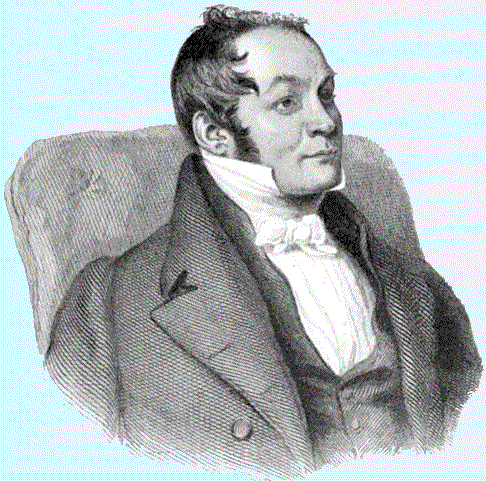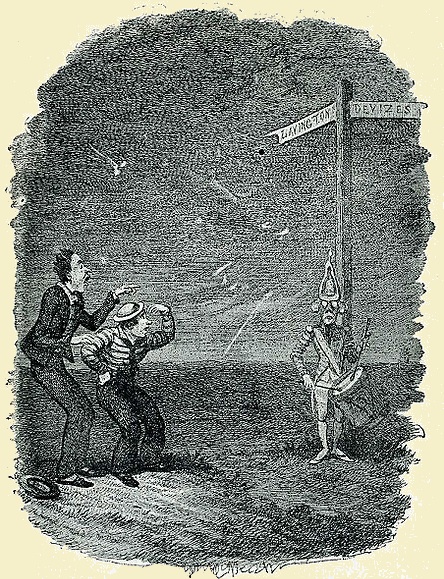Reverend Richard Harris Barham
The Reverend Richard Harris Barham, famous for his Ingoldsby Legends, was rector at St Dunstan in Snargate from 1817 to about 1821.
Barham, an English humourist better known by his pen name Thomas Ingoldsby, was born in Canterbury in 1788. At seven years of age he lost his father, who left him a small estate, part of which was the manor of Tappington, so frequently mentioned in the Legends.
At nine he was sent to St Paul's school, but his studies were interrupted by an accident which shattered his arm and partially crippled it for life. Thus deprived of the power of bodily activity, he became a great reader and diligent student. In 1807 he entered Brasenose College, Oxford, intending at first to study for the profession of the law. Circumstances, however, induced him to change his mind and to enter the church.
In 1813 he was ordained and took a country curacy and married in the following year. He was moved to Snargate in 1817, whilst continuing to live at Warehorne, but suffered a serious accident in 1819. The enforced rest giving him the opportunity to write.
In 1821 he was removed to London on obtaining the appointment of minor canon of St Paul's cathedral. Three years later he became one of the priests in ordinary of the King's Chapel Royal, and was appointed to a city living. In 1826 he first contributed to Blackwood's Magazine; and on the establishment of Bentley's Miscellany in 1837 he began to furnish the series of grotesque metrical tales known as The Ingoldsby Legends.
These became very popular, were published in a collected form and have since passed through numerous editions. In variety and whimsicality of rhymes these verses have hardly a rival since the days of Hudibras. But beneath this obvious popular quality there lies a store of solid antiquarian learning, the fruit of patient enthusiastic research, in out-of-the-way old books, which few readers who laugh over his pages detect.

Richard Harris Barham 1788-1845
His life was grave, dignified and highly honoured. His sound judgment and his kind heart made him the trusted counsellor, the valued friend and the frequent peacemaker; and he was intolerant of all that was mean and base and false. In politics he was a Tory of the old school; yet he was the lifelong friend of the liberal Sydney Smith, whom in many respects he singularly resembled. Theodore Hook was one of his most intimate friends. Barham was a contributor to the Edinburgh Review and the Literary Gazette; he wrote articles for Gorton's Biographical Dictionary; and a novel, My Cousin Nicholas (1834).
He retained vigour and freshness of heart and mind to the last, and his last verses ("As I laye a-thynkynge") show no signs of decay. He died in London after a long, painful illness, in June 1845. reference and more information.
![]() Reference and more information
Reference and more information
The Ingoldsby Legends is a collection of myths, legends, ghost stories and poetry written by Thomas Ingoldsby, a pen-name of an English clergyman named Richard Harris Barham. The legends were first printed during 1837 as a regular series in the magazine Bentley's Miscellany and later in New Monthly Magazine.
The legends were illustrated by John Leech and George Cruikshank. They proved immensely popular and were compiled into books published in 1840, 1842 and 1847 by Richard Bentley. They remained popular during the 19th century but have since become little known. An omnibus edition was published in 1879: The Ingoldsby Legends; or Mirth and marvels.
As a priest of the Chapel Royal, Barham was not troubled with strenuous duties and he had ample time to read and compose stories. Although based on real legends and mythology, such as the "hand of glory", they are mostly deliberately humorous parodies or pastiches of medieval folklore and poetry.
Probably Barham's most famous 'legend' was The Leech of Folkestone: Mrs. Botherby's Story, which contained the verse:
The World, according to the best geographers, is divided into Europe, Asia, Africa, America, and Romney Marsh. In this, and fifth, quarter of the globe, a Witch may still be occasionally discovered in favourable, i. e. stormy, seasons, weathering Dungeness Point in an eggshell, or careering on her broomstick over Dymchurch wall. A cow may yet be sometimes seen galloping like mad, with tail erect, and an old pair of breeches on her horns, an unerring guide to the door of the crone whose magic arts have drained her udder. I do not, however, remember to have heard that any Conjurer has of late been detected in the district.
![]() Read full text
Read full text
![]() Reference and more information
Reference and more information
Barham's legend The Leech of Folkestone: Mrs. Botherby's Story where he wrote The World, according to the best geographers, is divided into Europe, Asia, Africa, America, and Romney Marsh. In this, and fifth, quarter of the globe... led to Romney Marsh being known as The Fifth Continent.

Illustration of 'The Dead Drummer of Salisbury Plain', one fo teh Ingoldsby Legends


















